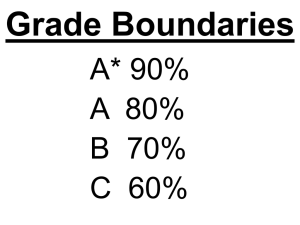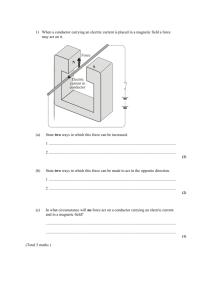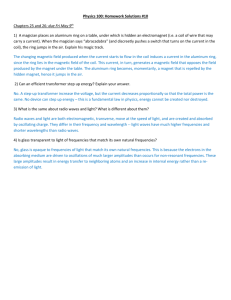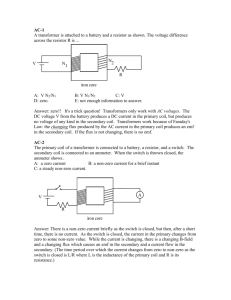Physics-HW-Chapters-353637-Due-May-16-Test-May
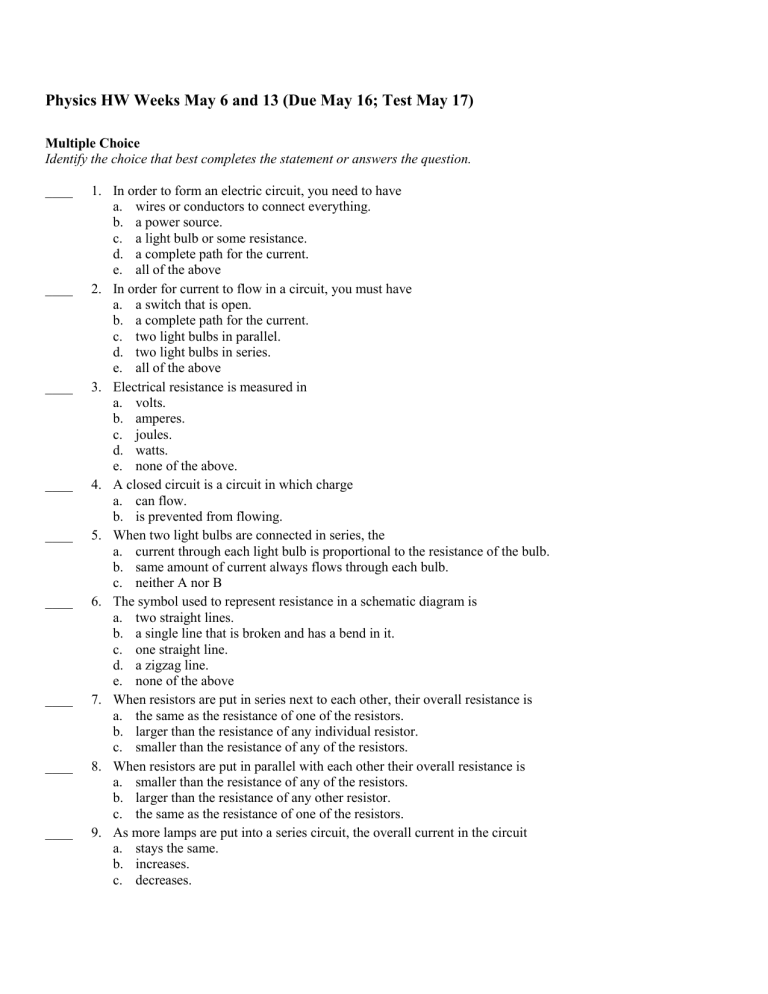
Physics HW Weeks May 6 and 13 (Due May 16; Test May 17)
Multiple Choice
Identify the choice that best completes the statement or answers the question.
____ 1. In order to form an electric circuit, you need to have a. wires or conductors to connect everything. b. a power source. c. a light bulb or some resistance. d. a complete path for the current. e. all of the above
____ 2. In order for current to flow in a circuit, you must have a. a switch that is open. b. a complete path for the current. c. two light bulbs in parallel. d. two light bulbs in series. e. all of the above
____ 3. Electrical resistance is measured in a. volts. b. amperes. c. joules. d. watts. e. none of the above.
____ 4. A closed circuit is a circuit in which charge a. can flow. b. is prevented from flowing.
____ 5. When two light bulbs are connected in series, the a. current through each light bulb is proportional to the resistance of the bulb. b. same amount of current always flows through each bulb. c. neither A nor B
____ 6. The symbol used to represent resistance in a schematic diagram is a. two straight lines. b. a single line that is broken and has a bend in it. c. one straight line. d. a zigzag line. e. none of the above
____ 7. When resistors are put in series next to each other, their overall resistance is a. the same as the resistance of one of the resistors. b. larger than the resistance of any individual resistor. c. smaller than the resistance of any of the resistors.
____ 8. When resistors are put in parallel with each other their overall resistance is a. smaller than the resistance of any of the resistors. b. larger than the resistance of any other resistor. c. the same as the resistance of one of the resistors.
____ 9. As more lamps are put into a series circuit, the overall current in the circuit a. stays the same. b. increases. c. decreases.
____ 10. As more lamps are put into a parallel circuit, the overall current in the circuit a. increases. b. stays the same. c. decreases.
____ 11. Compared to the resistance of two resistors connected in series, the same two resistors connected in parallel have a. less resistance. b. more resistance. c. the same resistance.
____ 12. When one light bulb in a series circuit containing several light bulbs burns out a. none of the other bulbs will light up. b. nothing changes in the rest of the circuit. c. the other light bulbs burn brighter.
____ 13. When one light bulb in a parallel circuit containing several light bulbs burns out, the other light bulbs a. do not burn at all. b. burn brighter. c. burn the same as before.
____ 14. In a simple parallel circuit a. current through each branch is always the same. b. voltage across each branch is always the same. c. the value of each resistor is the same. d. the circuit won't work unless there is a fuse in it. e. none of the above
____ 15. In a simple parallel circuit a. voltage across each branch is the same. b. current through each resistor is inversely proportional to the resistance. c. current is divided at each branch. d. all of the above e. none of the above
____ 16. Electrical devices in our homes are connected in a. parallel. b. series.
____ 17. Fuses and circuit breakers are used to a. protect us. b. prevent overloading. c. keep wires from getting overheated. d. break the circuit when too much current is being used. e. all of the above
____ 18. A short circuit occurs when a. the positive wire is connected directly to the negative wire. b. very short wires are used in the circuit. c. current lasts in the circuit for only a short time. d. all of the above e. none of the above
____ 19. Two lamps, one with a thick filament and one with a thin filament, are connected in series. The current is greater in the lamp with the a. thin filament. b. thick filament. c. Current is the same in each lamp.
____ 20. Two lamps, one with a thick filament and one with a thin filament, are connected in parallel to a battery. The voltage is greater across the lamp with the a. thin filament. b. thick filament. c. Both voltages are the same.
____ 21. Two lamps, one with a thick filament and one with a thin filament, are connected in parallel to a battery. The current is larger in the lamp with the a. thick filament. b. thin filament. c. Current is the same in both.
____ 22. Two lamps, one with a thick filament and one with a thin filament, are connected in series to a battery. The voltage is greater across the lamp with the a. thin filament. b. thick filament. c. Voltage is the same for both.
____ 23. A 60-W light bulb is connected to a 12-V car battery. When another 60-W bulb is connected in parallel with the first bulb, the battery's output energy a. doubles. b. halves. c. remains the same.
____ 24. The total resistance of a 10-ohm resistor and a 7-ohm resistor in series is a. 2 ohms. b. 3 ohms. c. 7 ohms. d. 17 ohms. e. 70 ohms.
____ 25. The total resistance of a 6-ohm resistor and a 12-ohm resistor in parallel is a. 4 ohms. b. 6 ohms. c. 18 ohms. d. 20 ohms. e. 73 ohms.
____ 26. A 60-W light bulb and a 100-W light bulb are both connected in parallel to a 120-V outlet. Which light bulb has more current in it? a. the 100-W bulb b. the 60-W bulb c. Both have the same current.
____ 27. The current through two identical light bulbs connected in series is 0.25 A. The total voltage across both bulbs is 120 V. The resistance of a single light bulb is a. 24 ohms. b. 48 ohms. c. 240 ohms. d. 480 ohms. e. none of the above
____ 28. The source of all magnetism is a. moving electric charges. b. ferromagnetic materials. c. tiny domains of aligned atoms. d. tiny pieces of iron. e. none of the above
____ 29. Moving electric charges will interact with a. an electric field. b. a magnetic field. c. both A and B d. none of the above
____ 30. An iron rod becomes magnetic when a. positive charges line up on one side and negative charges on the other side. b. positive ions gather at one end and negative ions at the other end. c. its electrons stop moving and point in the same direction. d. the net spins of its electrons point in the same direction. e. none of the above
____ 31. Surrounding every moving electron is a. an electric field. b. a magnetic field. c. both A and B d. none of the above
____ 32. Magnetism is produced by the motion of electrons as they a. move around the nucleus. b. spin on their axes. c. both A and B d. none of the above
____ 33. If the north pole of one magnet is brought near the south pole of another magnet, the poles will a. repel each other. b. attract each other. c. not interact with each other at all.
____ 34. If you break a bar magnet in half, each half a. becomes a bar magnet with two poles. b. becomes unmagnetized. c. contains one magnetic pole.
____ 35. If you put a small compass in a magnetic field, the compass will a. line up in a direction parallel to the magnetic field lines. b. swing randomly. c. line up in a direction perpendicular to the magnetic field lines. d. seek electrical charge concentrations.
____ 36. Magnetic field strength is a. strongest close to a magnet. b. constant everywhere around a magnet. c. strongest far from a magnet.
____ 37. Magnetic fields are produced by a. moving particles of Earth. b. charges at rest. c. moving particles. d. moving charged particles. e. none of the above
____ 38. Magnetic domains are a. regions that may or may not be magnetized. b. clusters of atoms randomly aligned. c. regions of atoms magnetically aligned. d. blocks of material.
____ 39. Permanent magnets can be made by a. placing a piece of iron near a strong electromagnet. b. placing a piece of iron in a strong magnetic field. c. stroking material containing iron with a magnet. d. all of the above e. none of the above
____ 40. The reason a magnet can attract an unmagnetized nail is that a. nails really are magnetized. b. nails become temporarily magnetized in a magnetic field. c. nails become permanently magnetized in a magnetic field. d. a magnet can attract any metal object.
____ 41. When current passes through a wire, a magnetic field is created around the wire only if the a. wire is absolutely straight. b. wire is curved in a loop. c. current makes a complete loop. d. current comes from a battery. e. A magnetic field is always created around the wire.
____ 42. A wire carrying a current is bent into a loop. The magnetic field is strongest a. at the center of the loop. b. at the edges of the loop. c. where the loop is located.
____ 43. In order to make an electromagnet, you need a a. battery, a nail, and a magnet. b. battery, some wire, and a nail. c. loop of wire, contacts, and a battery. d. magnet, a nail, and some wires. e. none of the above
____ 44. A galvanometer can also be made into a. an ammeter. b. a voltmeter. c. both A and B d. none of the above
____ 45. Loops of wire in a motor rotate because a a. battery effectively pushes a loop around in the field. b. current exerts a force on the loop, causing it to rotate. c. magnetic field exerts forces on moving electrons in the loop. d. magnet attracts stationary electrons in the wire. e. none of the above
____ 46. The magnetic pole in the Northern Hemisphere is located a. in Alaska. b. in Canada. c. at the geographic North Pole. d. just north of the United States. e. none of the above
____ 47. Earth's magnetic field is most likely due to a. millions of small magnets buried in Earth. b. a magnetized solid inner core of Earth. c. convection currents in the molten part of Earth's interior. d. the rotation of Earth acting on all of Earth's electrons. e. none of the above
____ 48. The discrepancy between the orientation of a compass and true north is known as the a. radioactive effect. b. magnetic declination. c. magnetic effect. d. none of the above.
____ 49. The force on an electron moving in a magnetic field will be the largest when its direction a. is at an angle other than 90 degrees to the magnetic field direction. b. is perpendicular to the magnetic field direction. c. is the same as the magnetic field direction. d. is exactly opposite to the magnetic field direction. e. none of the above
____ 50. The intensity of cosmic rays bombarding Earth's surface is largest at the a. equator. b. mid-latitudes. c. poles.
____ 51. Which of Earth’s geographic poles is nearest its magnetic north pole? a. South Pole b. North Pole c. both A and B
____ 52. Which pole of a compass needle points to a south pole of a magnet? a. south pole b. north pole c. both A and B
____ 53. If a compass is moved from the Northern Hemisphere to the Southern Hemisphere, its magnetic needle will change direction a. not at all. b. by 90 degrees. c. by 180 degrees. d. none of the above
____ 54. Magnetic field lines surrounding a magnet are conventionally drawn a. from south to north. b. from north to south. c. either way.
____ 55. Which force field can increase a moving electron's speed? a. electric field b. magnetic field c. both A and B d. none of the above
____ 56. Which force field can accelerate an electron, but never change its speed? a. electric field b. magnetic field c. both A and B d. none of the above
____ 57. Changing the magnetic field intensity in a closed loop of wires induces a. current. b. voltage. c. both current and voltage. d. neither current nor voltage.
____ 58. Electric current can best be induced in a wire by a. stretching the wire. b. moving a magnet up and down near the wire. c. setting the wire near a magnet. d. rotating the wire. e. none of the above
____ 59. A magnet is moved in and out of a coil of wire connected to a high-resistance voltmeter. If the number of coils doubles, the induced voltage a. is the same. b. doubles. c. quadruples. d. halves. e. none of the above
____ 60. A magnet is moved in and out of a coil of wire connected to several lamps. If the number of coils is doubled a. it is easier to move the magnet. b. there is no difference in moving the magnet. c. it is harder to move the magnet.
____ 61. The phenomenon of inducing voltage by changing the magnetic field around a conductor is called a. electromagnetic induction. b. generated voltage. c. Faraday's induction. d. electromagnetic radiation. e. transformer induction.
____ 62. A device consisting of a coil that is mechanically rotated in a stationary magnetic field is called a. a motor. b. a magnetic pole. c. a generator. d. a transformer. e. a dipole.
____ 63. A generator is used to light a bulb. Energy for lighting the bulb actually comes from a. a plug where the generator is connected to the wall. b. a mechanical input to the generator. c. the magnet in the generator. d. the coil of wire. e. none of the above
____ 64. The magnetic field strength inside a current-carrying coil will be greater if the coil encloses a a. vacuum. b. iron rod. c. wooden rod. d. glass rod. e. none of the above
____ 65. A device that transforms electrical energy to mechanical energy is a a. generator. b. transformer. c. magnet. d. motor. e. none of the above
____ 66. If a magnet is pushed into a coil, voltage is induced across the coil. If the same magnet is pushed into a coil with a greater speed a. a larger voltage is induced. b. a smaller voltage is induced. c. the same voltage is induced.
____ 67. The principal reason voltage is induced in the loops of a generator coil is that the a. loops are rotating, changing the amount of magnetic field within the loops. b. size of the loops is changing. c. magnet's strength is changing. d. magnet is rotating. e. all of the above
____ 68. Most commercial generators are driven by a. wind. b. falling water. c. steam. d. rain.
____ 69. A device that uses two coils around an iron core to change the voltage across a circuit is called a a. voltmeter. b. motor. c. transformer. d. generator. e. diode.
____ 70. In an electromagnetic wave, the electric and magnetic fields are _____ to each other and _____ to the direction of wave motion. a. opposite, parallel b. at right angles, perpendicular c. parallel, at right angles d. at right angles, parallel
____ 71. If the primary coil of a transformer were connected to a DC power source, the transformer would operate a. the same as always. b. at very low efficiency. c. only while being connected or disconnected. d. only if the output were also DC voltage. e. none of the above
____ 72. A transformer works because a. electricity flows from a primary coil to a secondary coil. b. electricity is induced in a rotating coil. c. a changing magnetic field is transferred to a coil via an iron core. d. electricity is transferred to a coil via an iron core.
____ 73. An electric motor and an electric generator are a. entirely different devices. b. very similar devices.
____ 74. A transformer transforms a. magnetic field lines. b. generators into motors. c. voltage. d. unsafe forms of energy into safe forms.
____ 75. A step-up transformer increases a. energy. b. power. c. both A and B d. none of the above
____ 76. The principal advantage of AC power over DC power is that a. AC voltage oscillates, whereas DC voltage does not. b. lower voltages are used. c. AC circuits multiply power more easily. d. AC voltage can be transformed more easily. e. AC circuits are safer.
____ 77. The primary coil of a transformer has 100 turns on it and the secondary coil has 50 turns on it. This is a. a step-down transformer. b. a step-up transformer. c. either of the above, depending on relative input and output currents
____ 78. If a transformer increases AC voltage, it will also increase a. energy. b. magnetic field strength. c. power. d. current. e. none of the above
____ 79. Almost all energy sold today is of the AC type because a. DC voltages don't last. b. DC energy wastes electricity. c. AC voltage is easy to step up and step down. d. AC energy was established first.
____ 80. Cross-country power lines carry voltages of about a. 60 V. b. 120 V. c. 2200 V. d. 120,000 V.
____ 81. An electromagnetic wave is composed of a. regions where charges vibrate at high frequency. b. vibrating regions of space. c. transverse vibrations of charges in space. d. perpendicular electric and magnetic fields vibrating together. e. none of the above
____ 82. Electromagnetic waves travel at a speed a. equal to the speed of light. b. greater than the speed of light. c. less than the speed of light.
____ 83. The voltage across a transformer primary coil that has 50 turns is 25 V. What is the voltage across the secondary coil, which has 20 turns? a. 2 V b. 10 V c. 20 V d. 40 V e. 50 V
____ 84. Neon signs require about 12,000 volts to operate. If a sign is operated by a transformer connected to a 120-V power source, the ratio of primary to secondary turns on the transformer should be a. 1:100. b. 100:1. c. none of the above
____ 85. A step-up transformer has a ratio of 1:10. If 200 W of power goes into the primary coil, the power coming from the secondary coil is approximately a. 2 W. b. 20 W. c. 200 W. d. 2000 W. e. more than 2000 W.
____ 86. The voltage across the input terminals of a transformer is 140 V. The primary has 20 loops and the secondary has 10 loops. The voltage the transformer puts out is a. 10 V. b. 70 V. c. 140 V. d. 280 V. e. none of the above
____ 87. 5 amps of current exist in the primary coil of a transformer. The voltage across the primary coil is 190 V.
What is the approximate power output of the secondary coil? a. 38 W b. 190 W c. 950 W d. 1900 W e. impossible to determine
____ 88. A certain transformer doubles input voltage. If the primary coil has 12 A of current, then the current in the secondary coil is a. 2 A. b. 6 A. c. 12 A. d. 24 A. e. none of the above
Problem
89. How many 6-ohm resistors must be connected in parallel to create an equivalent resistance of 1 ohm?
90. What is the equivalent resistance of a 30-ohm and a 20-ohm resistor connected in parallel?
91. Two identical resistors in parallel have an equivalent resistance of 7 ohms. If the same resistors were instead connected in series, what would be the equivalent resistance?
92. A 30-V potential difference is applied across a series combination of an 8.0-ohm resistor and a 3.0-ohm resistor. What is the current in the 8.0-ohm resistor?
93. A 60-V potential difference is applied across a parallel combination of a 10-ohm and a 20-ohm resistor. What is the current in the 10-ohm resistor?
94. A 20.0-V potential difference is applied across a parallel combination of a 60.0-ohm and a 10.0-ohm resistor.
What is the current in the 10.0-ohm resistor?
95. A 2.0-ohm resistor is connected in series with a 20.0-V battery and a three-branch parallel network with branches whose resistances are 6.0 ohms each. Ignoring the battery's internal resistance, what is the current in the battery?
96. A portable radio that requires low voltage uses a transformer that steps
140 V down to 14 V. What is the transformer's primary/secondary turns ratio?
97. The primary to a transformer has 1500 turns and is connected to a 150-V source. What number of turns on the secondary will produce 15 V?
98. The primary to a transformer has 500 turns and is connected to a 100-V source. What number of turns on the secondary will produce 800 V?
99. A step-up transformer has 40 turns on its primary and 100 turns on its secondary. When the primary is supplied with an alternating current at 140 V, what is the voltage across the secondary?
100. A step-up transformer has 250 turns on its primary and 500 turns on its secondary. When the primary is connected to 120 V and the secondary is connected to a floodlight that draws 5 A, what is the power output?
